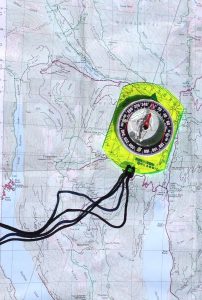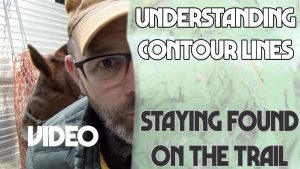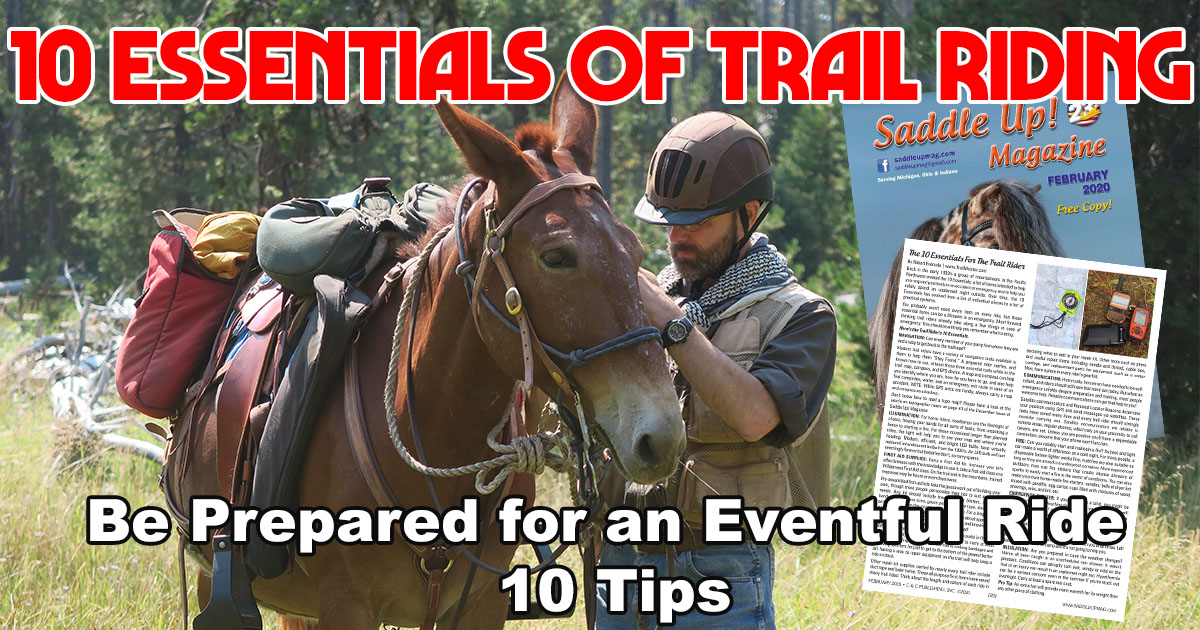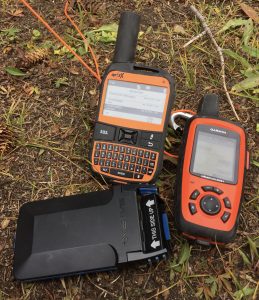The Essentials of Trail Riding – Back in the early 1930’s a group of mountaineers in the Pacific Northwest created the 10 Essentials; a list of items intended to:
- To help you respond positively in an accident or emergency
- To help you safely spend an unplanned night outside
Over time, the 10 Essentials has evolved from a list of individual items to a list of practical systems.
We’ve taken this list and modified it for trail riders – The Essentials of Trail Riding
As published in the February 2020 issue of Saddle Up Magazine
You probably won’t need every item on every ride, but these essential items can be a lifesaver in an emergency. Most forward thinking trail riders already take along a few items in case of emergency. This checklist will help you remember what to bring. Here are the 10 Essentials of Trail Riding.

Map and compass
NAVIGATION: Can every member of your party find where they are and a way to get back to the trailhead?
Modern trail riders have a variety of navigation tools available to them to help them “Stay Found.” A prepared rider carries, and knows how to use, at least these three essential tools while on the trail: map, compass, and GPS device. A map and compass can help you identify where you are, how far you have to go, and also help find campsites, water, and an emergency exit route in case of an accident. NOTE: While GPS units are handy, always carry a map and compass as a backup. A compass equipped with a sighting mirror can also be used to flash sunlight to a helicopter or rescuer during an emergency. Here’s the compass we use – https://amzn.to/2SCjhsD
Don’t know how to read a topo map? We’ve got you covered! – https://www.trailmeister.com/8-map-features-to-know/ 
ILLUMINATION: For horse riders, headlamps are the flashlight of choice, freeing your hands for all sorts of tasks, from untacking a horse to starting a fire. For those occasional longer than planned rides the light will help you to see your map and where you’re heading. Modern, efficient, and bright LED bulbs have virtually replaced incandescent bulbs from the 1900’s. An LED bulb will last seemingly forever but batteries don’t, so carry spares. Here’s the headlamp we use – https://amzn.to/3budmym
FIRST AID SUPPLIES: Carry and know how to use a 1st Aid kit. Increase your kit’s effectiveness with knowledge: take a first-aid class with the American Red Cross or a Wilderness First Aid class. On the trail and in the mountains, trained response may be hours or even days away.
Pre-assembled first-aid kits take the guesswork out of building your own, though most people personalize their kits to suit individual needs. Any kit should include treatments for blisters, adhesive bandages of various sizes, gauze pads, adhesive tape, disinfecting ointment, and over-the-counter pain medication. For a longer term ride or backcountry pack trip talk your physician about appropriate prescription medications. Carrying a 1st Aid Kit, and knowing how to use it, can help make a bad situation a lot less bad! Here’s the one we use – https://amzn.to/2UGc7WS
REPAIR KIT: Knives, or multi-purpose tools are so useful in first aid, food preparation, and repairs that every rider needs to carry at least one. From repairing broken tack on the trail to making bandages and removing splinters (or just to get to the bottom of the peanut butter jar) having a way to repair equipment on the trail will help keep a ride on track.
Other repair kit supplies carried by nearly every trail rider include duct tape and baler twine. These all-purpose fix-it items have saved many trail rides! Think about the length and nature of each ride in deciding what to add to your repair kit. Other tools such as pliers and useful repair items including needle and thread, cable ties, cordage, and replacement parts for equipment such as a water filter, have a place in every riders gear list. Here’s the knife we use – https://amzn.to/2SyZWZv
 COMMUNICATION: Historically, horsemen have needed to be completely self-reliant, and riders should still have that mindset today. But when an emergency unfolds despite preparation and training, most people welcome help.
COMMUNICATION: Historically, horsemen have needed to be completely self-reliant, and riders should still have that mindset today. But when an emergency unfolds despite preparation and training, most people welcome help.
Satellite communicators and Personal Locator Beacons determine your position using GPS and send messages via satellites. These tools have saved many lives and every trail rider should strongly consider carrying one. Satellite communicators are reliable in remote areas, regular phones, which rely on your proximity to cell towers, are not. Unless you are positive you’ll have a dependable connection, assume that your phone won’t function.
More on the Top 3 Satellite Communicators – https://www.trailmeister.com/satellite-messengers-when-the-phone-has-no-service/
FIRE: Can you reliably start and maintain a fire? Its heat and light can make a world of difference on a cold night. For many people, a disposable butane lighter works fine, matches are also suitable so long as they are stored in a waterproof container. More experienced outdoorsmen use fire strikers that create intense showers of sparks to easily start a fire in the worst of conditions.
You can also make your own home-made fire starters: candles; balls of dryer lint mixed with paraffin; egg-carton cups filled with mixtures of wood shavings, wax, & lint; etc. Here’s the one we use – https://amzn.to/39oAJro
EMERGENCY SHELTER: If you’re really in a bind, you might be waiting for a rescue. Anything that can keep you warm and dry will be appreciated in such a situation. Tarps, emergency blankets, or even large sized plastic garbage bags can provide a way to protect yourself, or others, from the elements in an emergency situation. Emergency “space blankets,” are a cheap, lightweight, and compact tool that can help if you get stranded or injured on the trail.
NOTE: A shelter is only useful if you have it with you at all times. A shelter left behind at your trailer or camp is not going to help you. Here’s the one we use – https://amzn.to/2UI0EGo
INSULATION: Are you prepared in case the weather changes? We’ve all been caught in an unscheduled rain shower. It wasn’t pleasant. Conditions can abruptly turn wet, windy or chilly on the trail or an injury can result in an unplanned night out. Hypothermia can be a serious concern even in the summer if you’re stuck out overnight in the cold. Carry at least a spare rain coat. Here’s the one we use – https://amzn.to/2vk9C1X
Pro Tip: An extra hat will provide more warmth for its weight than any other piece of clothing.
HYDRATION: We humans are 60% water and we’re constantly losing it! Without enough water, your body’s muscles and organs won’t function as intended. Always carry at least one water bottle or hydration bladder. Wide-mouth containers are easier to refill. Make sure to always start a ride with a full water bottle and have the skills and tools required to obtain and purify additional water if necessary. In most environments, you need to have the ability to treat water – by filtering, using purification chemicals, or boiling. Here’s the one we use – https://amzn.to/2OIgexN
NUTRITION: I’m always glad to find an extra snack in the bottom of my saddle bags. Extra food helps keep up your energy and morale. Carry extra high-calorie, nutrient-dense food that lasts a long time, requires no cooking, and is easily digestible. Combinations of jerky, nuts, candy, and granola work well. If you’re a dedicated coffee drinker a few packets of instant will provide a caffeine fix and help you keep a clear head. Here’s my favorite trail snacks! – https://amzn.to/3bqRdkC
COMMON SENSE: It’s the most important of the 10 Essentials of trail riding. Having the right gear is one thing, knowing how and when to use it is quite another. Often, it’s not a person’s equipment that saves them. It’s their experience, know-how, and good judgment.
Inexperience, or a lack of good judgment, is what gets people into trouble. Not only must we have the proper equipment, including the ten essentials listed above. We we must also have the knowledge to use these tools effectively. Take the time and effort to develop a better understanding and greater knowledge of the outdoors. Go beyond just horsemanship skills, it’ll make for much better trails and camping trips.
As always for more information on trail riding, horse camping, and the world’s largest database of horse trails visit www.TrailMeister.com









